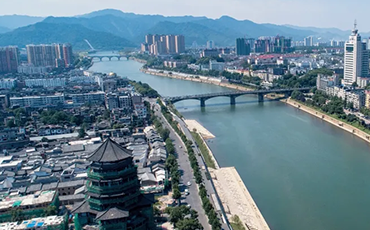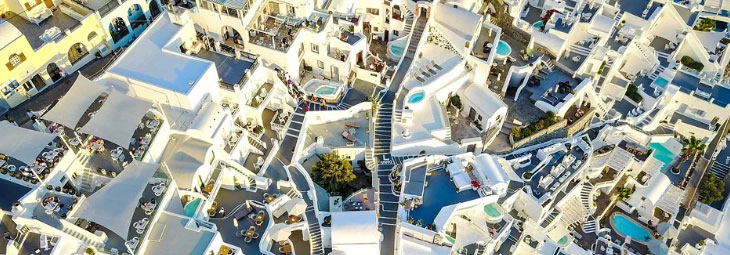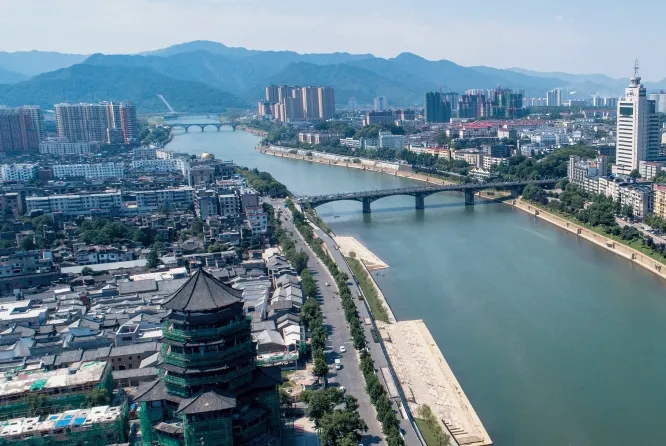



Source: Guihuazhongguo
With a history of more than 2,000 years of pottery smelting, more than 1,000 years of official kiln history, and more than 600 years of imperial kiln history, Jingdezhen can be said to have been born and prospered because of porcelain. The blending of clay and fire has created countless breathtaking arts, accomplishing the miracle of a city that has flourished for thousands of years with only a single handicraft industry.
“Three sides of green mountains and one side of water, a city of porcelain and half a city of kilns.” Guo Moruo in jingdezhen art porcelain factory visit improvisation, inscribed poem praise: “China to the number of porcelain country, the peak of the porcelain industry is this all. Since the Song Dynasty, passed the credibility of the State of China and outside the uniform loss.” Through a thousand years of history, porcelain, is still the city's most distinctive mark.
1.Porcelain has the same name as“China”.
Jingdezhen, since ancient times, “soil and water suitable for pottery”. The so-called “one side of the porcelain soil breeding one side of the porcelain art”, in this piece of land born for the porcelain, it seems that a piece of grass and trees can be porcelain service. Because it is located in the hilly area of Jiangnan, the surrounding mountains are not only dotted with rich porcelain raw materials and lush forests, but also became a natural barrier against war in ancient times. Relatively closed environment, but in times of war is a kind of shelter. The end of the Northern Song Dynasty, the war, the former famous kilns or deserted decline, or with the destruction of the war, rare isolated in the northeast corner of Gan Jingdezhen can be preserved. After the Jingkang change, used to make a living by porcelain kiln workers in the north began to move south, they will be advanced porcelain production technology to bring here.
The flowing mother river, the Changjiang River, is also an important factor in the development of Jingdezhen's porcelain industry. Chang River through the town, is a veritable river of wealth, the river of life. Prosperous water transportation not only brought porcelain raw materials, fuel and household goods, the current also provides power for kiln production. In order to save manpower, improve efficiency, and then most of the kilns built by the river, a long and narrow strip of towns and cities along the Changjiang River north and south stretches for more than 10 miles, constituting the urban layout of Jingdezhen.
Pine oil and grease, burning long flame, high heat, is the ideal fuel for firing porcelain. As a well-known bamboo and wood town, Jingdezhen has abundant pine resources, its kiln's fuel is mostly only locally sourced, saving freight costs, reducing costs and enhancing competitiveness.
It is thanks to this that Jingdezhen's porcelain has long been famous and exported overseas. When foreigners see the beautifully made porcelain, they all wonder. And the English “porcelain” and “China” are the same word “china”, invariably also let Jingdezhen porcelain capital status more prominent.
2.Spring and Autumn in an Ancient Lane.
“Four mountains and eight docks, nine streets and ten alleys, three continents and four wharves, one hundred and eight lanes.” Since the Tang and Song dynasties, Jingdezhen has been “building kilns along the river and becoming a city because of the kilns”. There are countless lanes on both sides of the river, some of these old streets and lanes are named for the flourishing trade, such as the firecracker lane, embroidery ball lane, etc., and some of them are named after the surnames of large families on the street, such as Jiangjia Lane, Pengjia Lane, etc., which have witnessed the historical changes of the city.
According to “Jingdezhen City, Jiangxi Province Geographical Names” records, as early as the end of the Tang Dynasty, Peng Jia Lane location will be gathered more than one family Peng porcelain makers. To the middle of the Song Dynasty, due to the rapid development of the porcelain industry, kiln households and billet houses are increasing, the gradual formation of the Lilong, it was named “Pengjialang”.
The neat horse head walls are lined up in order, and the green and red brick walls are covered with green moss, which tell the story of the vicissitudes of time in Pengjialiang. In the middle of the road is a green stone plate, on both sides is densely abandoned kiln bricks, kiln bricks by the high-temperature experience, hard, brick skin layer commonly known as “kiln sweat” of brown glaze. Although the houses in the alley show a variety of styles, but without exception, all with kiln brick wall, with kiln slag slope, strong and solid and permeable, which is also the Jingdezhen ancient alley building distinctive features. The whole old street is built according to the distribution of ancient kilns, set “kiln, work, residence, factory” in one, therefore, part of the houses in the middle of a short section of the “footbridge”, used to shorten the distance of the porcelains and reduce the damage of the transportation process. The kiln ruins, workshops, houses and other historical monuments retain clear traces of the production and life of the people of Jingdezhen. In this old alley, people and ceramic cultural imprints can be seen everywhere, as if into those once hot kiln factory, a scene after a moving scene to the people:
An early morning in the Song Dynasty, when the first ray of sunshine sprinkled Jingdezhen, a narrow lane connecting hundreds of kilns and workshops, along the east-west direction straight to the sparkling Changjiang River, exquisite and elegant porcelain in the point of the sails to the faraway places, became China to the world, the world to recognize the cultural symbols of China.
More detailed can be accessed by:https://mp.weixin.qq.com/s/9w-kXYRmPtXiRVC8LxROrA
Edited and Translated by Tao Guan